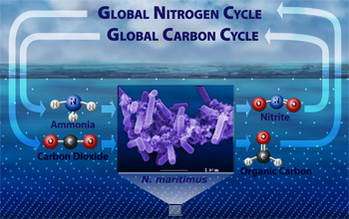Marine Microorganism Suspected to Play Role in Global Carbon and Nitrogen Cycles

Scientists are now revisiting, and perhaps revising, their thinking about how Archaea, an ancient kingdom of single-celled microorganisms, are involved in maintaining the global balance of nitrogen and carbon. Researchers have discovered the first Archaea known to oxidize ammonia for energy and metabolize carbon dioxide by successfully growing the tentatively named, Nitrosopumilus maritimus, in the lab.
Image: Researchers discovered that Archaea may play a key role in global nitrogen and carbon cycling. Illustration created by Nicolle Rager Fuller, National Science Foundation. Micrograph image provided by M. Koenneke and D. Stahl, University of Washington
"Data from several cultivation-independent, molecular experiments led us to suspect that Archaea could be involved in the marine nitrogen cycle. Subsequently having the organism isolated in the lab allowed us to confirm our suspicions," said David Stahl, professor of civil and environmental engineering at the University of Washington. Stahl's lab group specializes in environmental microbiology and how microbial communities function in diverse locations including the oceans, hot springs, animal intestines and the human mouth.
Archaea have primarily been associated with extreme environments like hot springs and deep-sea vents, but about a decade ago molecular studies proved their abundance in more common environs including the open ocean, freshwater and soil. Subsequent efforts to grow various samples of these organisms led to this cultivation of N. maritimus, or "dwarf belonging to the sea," by Stahl and scientists at the Woods Hole Oceanographic Institution.
They report their work in the Sept. 22 issue of the journal Nature.
As the true range and relationship of Archaea to other microbes is revealed, information about N. maritimus will serve as benchmarks for all microbiologists. Biochemical and genomic studies are already underway to learn the mechanisms by which N. maritimus uses nitrogen and how its physiology compares to other microorganisms.
The National Science Foundation's (NSF) Microbial Observatories (MO) program as well as an NSF postdoctoral fellowship in microbial biology supported this work. In addition to molecular and genome-enabled studies, the MO program funds new developments in the laboratory cultivation of novel microorganisms—a worthy endeavor considering that less than 1 percent of Earth's microorganisms have been cultured in the lab.
Matt Kane, NSF program manager for this research said, "This is a great example of how new approaches to microbial cultivation and cutting-edge molecular techniques can complement one another to achieve big advances in our understanding of the complexity of our global ecosystem." Kane says studies like these continue to highlight the importance of non disease-causing microorganisms and their critical role in our understanding of global environmental cycles.
Source: NSF















